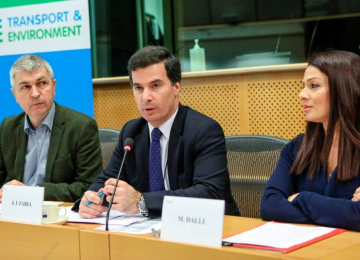The Paris climate agreement’s target of limiting global warming well below 2°C will be impossible without measures to curb shipping’s greenhouse gas emissions, MEPs told industry representatives last week. Including shipping CO2 in the EU’s emissions trading system (ETS) or having the sector contribute to a climate compensation fund were the options on the table, they said.
MEPs from four political groups – the conservatives (EPP), the socialists (S&D), the liberals (ALDE) and the left-wing GUE – said the revision of the EU ETS, currently underway, needs to include shipping emissions in the EU 2030 climate target and contribute to meeting the Paris limits. Shipping is the only sector of the European economy not covered by the EU’s existing emissions reduction target.
‘The IMO promised numerous times to regulate shipping emissions – and nothing happened,’ liberal MEP José Inácio Faria (pictured) said at the policy discussion in the European Parliament. ‘We wish you, the IMO, were with EU on cutting shipping emissions, but you are at the bow and we are at the stern of this ship.’
Shipowners oppose action at EU level, though Patrick Verhoeven of the European Community Shipowners’ Associations (ECSA) told MEPs the industry would be willing to contribute to a global climate compensation fund. John Andreopoulos of the Union of Greek Shipowners (UGS) also warned against EU action but said industry could consider contributing to a global compensation fund.
But having shipping contribute to an EU compensation fund would allow money to be re-invested in the shipping sector through research funding for cleaner technology, T&E’s clean shipping director, Bill Hemmings, told MEPs. ‘It will be up to the shipping companies to decide whether they want to be subject to the EU ETS rules or to contribute to an EU compensation fund,’ he added.
‘What is not negotiable after Paris is that shipping needs to contribute to the global emissions reduction,’ Bill Hemmings continued. ‘Without this it will be impossible to achieve the ambitious Paris long-term target. The EU needs to include shipping in its 2030 reduction commitment now and in the ETS from 2021. Otherwise, if the IMO continues to fail, all that will be left is for MEPs to come back to the issue in 10 years’ time to discuss 2040 targets.’
A draft of the Parliament environment committee’s proposed reforms is expected by May. A committee vote could take place in September and a plenary decision either at the end of this year or the beginning of 2017.
Emissions from shipping pose a great challenge for EU climate policy. The Commission has called for actions that cover all sectors and sources of emissions, including international shipping. But currently maritime emissions are not included at all in the EU’s 2020 climate commitment.
The IMO, the UN body tasked with tackling emissions from the sector, has failed for decades to agree measures to reduce emissions in their sectors. On the contrary, emissions from international maritime transport have grown by 70% since 1990.
If treated as a country, CO2 emissions from international shipping rank between those of Germany and Japan. A recent European Parliament study found that shipping will be responsible for 17% of the total emissions in 2050 if left unregulated.
Source: Transport & Environment






























































